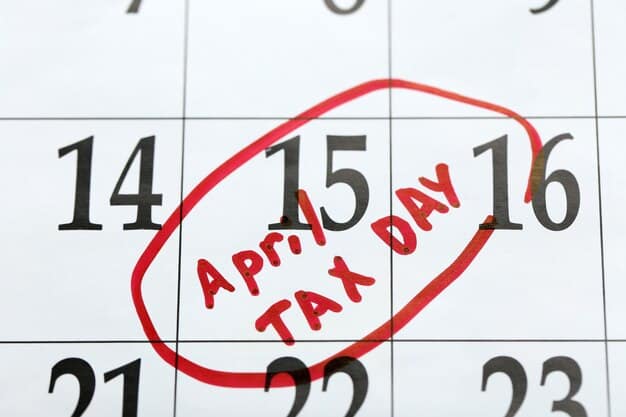Understanding Estimated Taxes: Avoid Penalties in 2025

Understanding estimated taxes is crucial for self-employed individuals, freelancers, and others with income not subject to regular withholding, allowing them to avoid underpayment penalties in 2025 by paying taxes throughout the year.
Navigating the world of taxes can be complex, especially when you’re self-employed, a freelancer, or have income streams not subject to regular withholding. Understanding Estimated Taxes: Avoid Underpayment Penalties in 2025 is crucial to avoid potential financial setbacks. Let’s delve into how estimated taxes work and what you need to know to stay compliant.
What are Estimated Taxes?
Estimated taxes are a method of paying income tax and self-employment tax (Social Security and Medicare taxes) throughout the year, rather than paying it all at once at the end of the tax year. This applies to individuals who don’t have taxes withheld from their income, such as those who are self-employed or receive income from investments, dividends, or rental properties.
Understanding if you need to pay estimated taxes and how to calculate them is essential to avoid penalties. Ignoring this responsibility can lead to unexpected financial burdens, so let’s break down the basics.
Who Needs to Pay Estimated Taxes?
Generally, you need to pay estimated taxes if you expect to owe at least $1,000 in taxes when you file your return. This typically includes self-employed individuals, freelancers, gig workers, partners, and S corporation shareholders who receive income not subject to withholding.
It’s crucial to assess your income and tax situation regularly to determine if you meet the threshold for paying estimated taxes. Changes in income, deductions, or credits can affect your tax liability.
Income Types Subject to Estimated Taxes
Several types of income are subject to estimated taxes. These typically include:
- Self-Employment Income: This includes income from freelancing, contracting, or running your own business.
- Interest and Dividends: If you receive significant income from investments, you may need to pay estimated taxes.
- Rental Income: Landlords who receive rental income must often pay estimated taxes.
- Alimony: If you receive alimony payments, you may be required to pay estimated taxes on that income.

Understanding these income types and their tax implications is crucial for accurately calculating your estimated tax liability and avoiding penalties.
Calculating Estimated Taxes for 2025
Calculating your estimated taxes involves estimating your expected adjusted gross income (AGI), taxable income, deductions, and credits for the year. This can be a complex process, but breaking it down into steps can make it more manageable. Start by gathering all relevant financial records and using the prior year’s tax return as a starting point.
Keep accurate records of your income and expenses, as this information will be crucial for calculating your estimated taxes and filing your tax return. Using accounting software or spreadsheets can help streamline the process.
Step-by-Step Calculation Guide
Here’s a simplified step-by-step guide to calculating your estimated taxes:
- Estimate Your Expected AGI: Project your income for the year, including all sources of income.
- Determine Your Deductions: Estimate your deductions, such as the standard deduction or itemized deductions.
- Calculate Taxable Income: Subtract your deductions from your AGI to determine your taxable income.
- Compute Your Tax Liability: Use the tax rates for the current year to calculate your income tax liability. Account for any applicable credits.
- Calculate Self-Employment Tax: If you are self-employed, calculate your self-employment tax liability.
- Determine Total Estimated Tax: Add your income tax and self-employment tax liabilities to determine your total estimated tax.
Resources for Tax Calculation
Several resources can assist you in calculating your estimated taxes accurately. You can use:
- IRS Form 1040-ES: This form includes worksheets to help you calculate your estimated taxes.
- Tax Software: Tax software programs can guide you through the calculation process and help you avoid errors.
- Tax Professionals: A qualified tax professional can provide personalized assistance and advice based on your specific financial situation.
Utilizing these resources can help ensure that you accurately calculate and pay your estimated taxes, reducing the risk of penalties.
Payment Deadlines and Methods
Paying estimated taxes on time is crucial to avoid penalties. The IRS typically divides the tax year into four payment periods. Knowing the deadlines and available payment methods is essential for staying compliant. Mark your calendar and plan ahead to ensure timely payments.
Missing the deadlines for estimated tax payments can result in underpayment penalties, so it’s important to stay organized and proactive.
Quarterly Payment Deadlines for 2025
For the 2025 tax year, the quarterly payment deadlines are generally:
- Quarter 1: April 15
- Quarter 2: June 15
- Quarter 3: September 15
- Quarter 4: January 15 of the following year
How to Pay Estimated Taxes
The IRS offers several convenient ways to pay your estimated taxes:
- IRS Direct Pay: You can pay directly from your bank account through the IRS website.
- Electronic Funds Withdrawal: You can schedule payments when e-filing your tax return.
- Credit or Debit Card: You can pay online or by phone through a third-party payment processor.
- Check or Money Order: You can mail a check or money order to the IRS with Form 1040-ES.

Choose the payment method that works best for you and ensure that you make your payments on time to avoid penalties.
Understanding Underpayment Penalties
Underpayment penalties occur when you don’t pay enough estimated tax or when you pay it late. The penalty amount varies based on how much you underpaid and how long the underpayment lasted. Understanding how these penalties are calculated and how to avoid them can save you money and stress.
Being proactive about your tax obligations and taking steps to minimize underpayment penalties is a financially smart decision.
How Underpayment Penalties are Calculated
The IRS calculates underpayment penalties based on:
- The Amount of the Underpayment: The difference between what you paid and what you should have paid.
- The Period of the Underpayment: The length of time the underpayment existed.
- The Interest Rate: The IRS charges interest on underpayments, which can vary over time.
These penalties can be substantial, so it’s crucial to avoid underpaying your estimated taxes.
Avoiding Underpayment Penalties
There are several strategies to avoid underpayment penalties:
- Pay Enough Estimated Tax: Ensure you pay at least 90% of your current year’s tax liability or 100% of the previous year’s tax liability (110% if your AGI was over $150,000).
- Increase Withholding: If you are also an employee, consider increasing your withholding from your paycheck to cover your tax liability.
- Use the Annualized Income Method: If your income varies throughout the year, this method allows you to adjust your estimated tax payments based on your actual income.
Implementing these strategies can help you avoid underpayment penalties and stay in good standing with the IRS.
Strategies for Accurate Tax Estimation
Accurate tax estimation is essential for avoiding underpayment penalties. Several strategies can help you improve the accuracy of your tax estimations, including using tax software, consulting with a tax professional, and keeping detailed records.
By implementing these strategies, you can gain better control over your tax obligations and minimize the risk of errors and penalties.
Using Tax Software
Tax software programs offer features that can help you accurately estimate your taxes, such as:
- Automatic Calculations: Tax software can automatically calculate your tax liability based on your income and deductions.
- Scenario Planning: You can use tax software to model different income scenarios and assess their impact on your tax liability.
- Error Checks: Tax software can identify potential errors and omissions in your tax calculations.
Consulting a Tax Professional
A qualified tax professional can provide personalized assistance and advice based on your specific financial situation. Benefits of consulting a tax professional include:
- Expert Knowledge: Tax professionals have in-depth knowledge of tax laws and regulations.
- Personalized Advice: They can provide customized advice based on your unique circumstances.
- Audit Support: They can represent you in the event of an audit.
Consulting a tax professional can provide peace of mind and ensure that you are meeting your tax obligations accurately.
Keeping Detailed Records
Maintaining detailed records of your income and expenses is crucial for accurate tax estimation. Good record-keeping practices include:
- Tracking Income: Keep records of all sources of income, including invoices, bank statements, and payment confirmations.
- Documenting Expenses: Keep receipts and records of all deductible expenses.
- Using Accounting Software: Employ accounting software or spreadsheets to organize and track your financial information.
Detailed records will make it easier to calculate your estimated taxes accurately and substantiate your deductions and credits.
Adjusting Your Estimated Tax Payments
Your income and financial situation can change throughout the year. It’s important to reassess your estimated tax liability periodically and adjust your payments accordingly. This proactive approach can help you avoid underpayment penalties and stay on track with your tax obligations.
Don’t set it and forget it. Regularly reviewing and adjusting your estimated tax payments is a financially responsible habit.
When to Adjust Your Payments
You should consider adjusting your estimated tax payments if you experience significant changes in your income, deductions, or credits. Examples of such changes include:
- Changes in Income: If your income increases or decreases significantly, you’ll want to adjust your estimated payments.
- Changes in Deductions: If you become eligible for new deductions or lose existing ones, you’ll need to reassess your tax liability.
- Changes in Credits: New or lost tax credits can greatly affect your tax obligation.
How to Adjust Your Payments
Adjusting your estimated tax payments can be done in several ways:
- Recalculate Your Estimated Tax: Use the IRS Form 1040-ES worksheets or tax software to recalculate your estimated tax liability.
- Adjust Future Payments: Increase or decrease your future payments to make up for any over or underpayments in previous quarters.
- Use the Annualized Income Method: If your income varies substantially throughout the year, this method can help you align your payments with your actual income.
By staying flexible and adjusting your payments as needed, you can minimize the risk of underpayment penalties and ensure that you are meeting your tax obligations.
| Key Point | Brief Description |
|---|---|
| 🗓️ Payment Deadlines | Quarterly deadlines: April 15, June 15, Sept 15, Jan 15. |
| 💰 Underpayment Penalties | Avoid penalties by paying at least 90% of current year’s tax. |
| 🧮 Accurate Estimation | Use records, tax software, or consult a tax professional. |
| 📈 Payment Methods | Options include IRS Direct Pay, card, or check. |
Frequently Asked Questions (FAQ)
▼
Estimated taxes are usually for those who are self-employed, freelancers, or have income not subject to regular withholding. Generally, if you expect to owe at least $1,000 in taxes, consider making estimated payments.
▼
The quarterly payment deadlines are generally April 15, June 15, September 15, and January 15 of the following year. Mark these dates on your calendar so payments are both accurate and timely.
▼
Make sure to pay at least 90% of your current year’s tax liability or 100% of the previous year’s (110% if AGI exceeded $150,000). Increasing withholding is another method to consider.
▼
Estimated taxes can be paid online through IRS Direct Pay or third-party processors. You can also pay by mail using a check or money order. Set up whichever method is most convenient.
▼
If you expect significant changes, recalculate your estimated tax; increase or decrease future payments, or switch to the annualized income method. Accurate forecasting is key.
Conclusion
In conclusion, understanding estimated taxes is crucial for financial health, especially for those with income not subject to regular withholding. By following the guidelines, understanding deadlines, and estimating appropriately, you can confidently navigate tax responsibilities and bypass those underpayment penalties in 2025.





